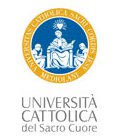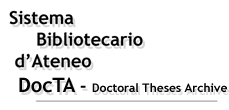|
|
DocTA - Doctoral Theses Archive >
Tesi di dottorato >
CORSO DI DOTTORATO IN SCIENCE >
Citazione:
Utilizza queste indicazioni per citare o creare un link a questo documento.
|
Costantino, Federica. "Advanced nanocomposites for photocatalytic degradation of organic pollutants in water", Università Cattolica del Sacro Cuore, XXXIII ciclo, a.a. 2020/21, Brescia, [http://hdl.handle.net/10280/112846].
|
| Titolo: | Advanced nanocomposites for photocatalytic degradation of organic pollutants in water |
| Autore/i: | COSTANTINO, FEDERICA |
| Tutor: | GAVIOLI, LUCA
KAMAT, PRASHANT V.
FRAGOULI, DESPINA |
| Coordinatore: | GAVIOLI, LUCA |
| Lingua: | ENG |
| Abstract in italiano della tesi: | L'inquinamento è uno dei problemi maggiri della nostra società. In particolar modo, l'inquinamneto relativo all'acqua sta diventando sempre più consistente considerando la cresita esponenziale del fabbisogno mondiale. Si stima che nel 2050 la domanda di acqua cresca fino al 50%. In questo scenario è necessario trovare una soluzione a tale problema. in questa tesi viene proposto un metodo innovativo per la fabbricazione di materiali polimerici additivati con nanoparticelle che sono in grado di degradadare inquinanti organici in acqua atterevro il processo della fotocatalisi. Questo metodo permette di degradare direttamente la sostanza inquinante in acqua, ovviando a diversi problemi relativi ai costi e al recupero post-trattamento del materiale utilizzato per la decontaminazione. |
| Abstract in inglese: | Water plays a vital role in sustain life on earth. However, the quality of the water resources is seriously affected by the pollution caused by industrial, municipal and agricultural activities. To remediate the toxic organic and inorganic contaminants in water, several physical, chemical and biological water treatment methods are employed. However, current water treatment technologies present limited performance, materials of high cost, and need highly energy consuming infrastructure. In this scenario, the utilization of advanced materials and innovative methods could be helpful for reducing the cost and enhancing the performance of the wastewater treatment. One of most promising method is the Advanced Oxidation Processes (AOPs). The AOPs use semiconductor materials that are activated by the UV or Visible light irradiation that are able to mineralize organic water pollutants. Currently, commercial available photocatalysts are mostly used in slurry or powder form, but this requires post-treatment processes in order to avoid secondary pollution, causing the increase of the overall treatment cost. To face up such limitation and to resolve problems related to the post-treatment process, the immobilization of the photocatalysts on solid compact matrices is a feasible solution. In particular, the use of polymeric matrices as host solid materials may result in a final system that combines the photocatalytic properties of the semiconductor component with the mechanical properties, usability and cost-effectiveness of the polymers. |
| Digital Object Identifier (DOI): | https://doi.org/10.1016/j.jphotochem.2020.112599 https://doi.org/10.3390/polym13060912 https://doi.org/10.1021/acsphyschemau.1c00035 |
| Data di discussione: | 14-feb-2022 |
| URI: | http://hdl.handle.net/10280/112846 |
| È visualizzato nelle collezioni: | CORSO DI DOTTORATO IN SCIENCE
|
File in questo documento:
| File |
Descrizione |
Dimensioni | Formato | Accessibilità |
|---|
| Dissertation_FCostantino.pdf | Tesi completa | 5,46 MB | Adobe PDF | Visualizza/apri
|
|
Accesso e utilizzo dei contenuti di DocTA
|



